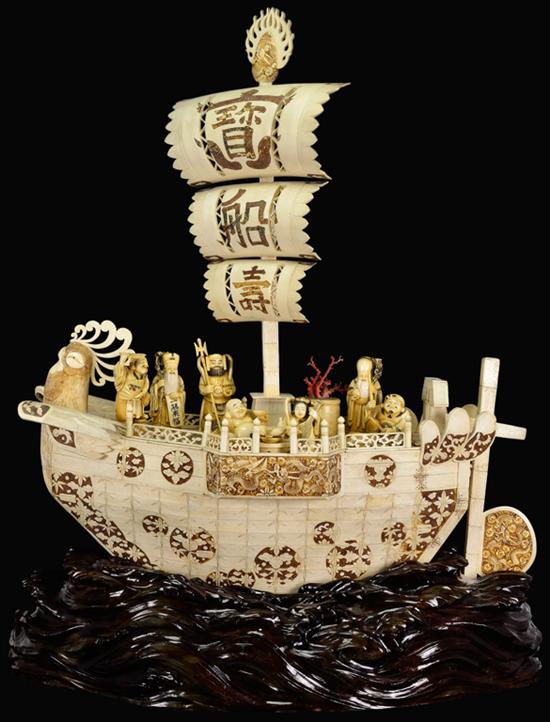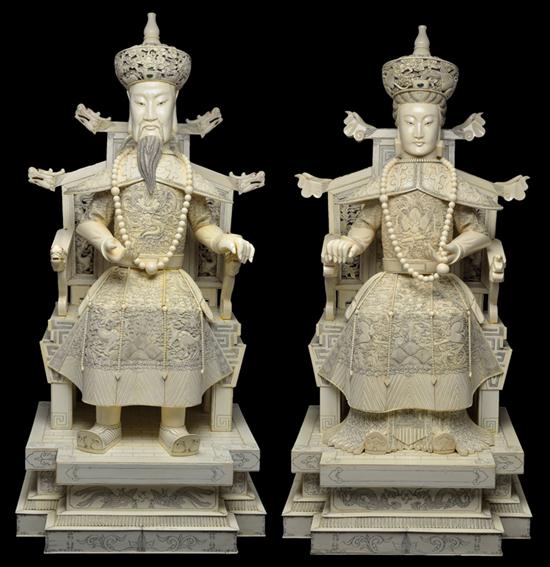
|
Subject:One of a kind ivory pieces
Posted By: Morton Thu, Nov 29, 2012 IP: 173.11.234.62
I am contacting you today from Morton Auctioneers. We have two huge, incomparable ivory sculptures; A Takarabune and a Pair of Enthroned Chinese Emperors, which we believe to the largest ivory sculptures of this type in the world. I am sending you the photos and descriptions as they may be of interest to you to exhibit.
These items will be available at our upcoming auction on Thursday, December 6, 2012 at 7:00 p.m. CST. I would encourage you to view the pieces and consider them as a lobby/conference room/Suite sculptures. Please see below photos of the items and their respective descriptions, and also a link to our website for additional information. Thank you for your time and for viewing these exquisite pieces, should you have any questions or need additional photos or information, please do not hesitate to contact Mark Sommerfield with Morton Auctioneers and Appraisers below:
Mark W. Sommerfield
Consignment Specialist & Senior Cataloguer
Morton Auctioneers & Appraisers
4901 Richmond Avenue
Houston, Texas 77027
713.827.7835
www.mortonkuehnert.com
A MONUMENTAL SIZE IVORY TAKARABUNE WITH SEVEN LUCKY GODS (We have not encountered a Takarabune this size outside of Japan).
Mid 20th Century
43 x 34 x 18 inches (109.2 x 86.4 x 45.7 cm).
This incomparable huge Takarabune (Treasure Ship) features the Seven Gods of Fortune (Shichi Fukujin), all hand carved from solid ivory. Each sail is carved from a tusk and incised with Japanese characters.
The Seven Gods of Fortune, commonly referred to in English as the Seven Lucky Gods, refer to the Seven Gods of Good Fortune in Japanese mythology and folklore. The Seven Lucky Gods of Japan are a group of deities whose origins stem from Indian, Chinese, and indigenous Japanese gods of fortune. The seven gods are often depicted on their ship, the Takarabune, as shown here. The tradition holds that the seven gods will arrive in town on the New Year and distribute fantastic gifts to worthy people. It is assumed that the first earnest believers of the Seven Lucky Gods were merchants, and that the first two gods of the seven to gain immediate popularity were Daikoku and Ebisu, the gods of commerce and merchants. Japanese society began to look amongst the pantheon of Gods to find one suitable for their own endeavors. Before long, the goddess Benten became the patroness of the arts. Fukurokuju, god of happiness and Jurojin, god of longevity as well as Hotei were Chinese imports who were gods and sages. The first two, Fukurokuju and Jurojin, began to have their following amongst the intellectual classes and the latter, Hotei, began to occupy a unique position among the other gods as the happy god of abundance and good health. Bishamon, god of warriors, was looked to by travelers, doctors and missionaries.
Provenance: Dr. Paul Pasha Collection, Houston, Texas.
Notes: "The Seven Lucky Gods of Japan" by Reiko Chiba
Very good condition.
Estimate $ 400,000-800,000 Opening Bid $200,000
A MONUMENTAL PAIR OF CHINESE CARVED IVORY ENTHRONED EMPERORS
Mid 20th Century
56 x 17 1/2 x 14 1/2 inches (142.2 x 44.5 x 36.8 cm).
Pair of huge Chinese carved Ivory Emperor and Empress figures. Each is seated on elaborate dragon and phoenix thrones respectively, both emperor and empress are dressed in dragon robes and wearing chao zhu court necklaces, with the empress holding the carved ivory pearls of her chao zhu court necklace in her left hand in meditation. Malachite cabochons adorn the headdresses of the emperor and empress, and small coral beads are in place of the eyes of the dragons and Fenghuang, or Chinese phoenixes, carved into their imperial thrones and robes.
Notes: Dragons traditionally symbolize potent and auspicious powers, particularly control over water, rainfall, hurricane, and floods. The dragon is also a symbol of power, strength, and good luck. With this, the Emperor of China used the dragon as a symbol of his imperial power and strength. According to Chinese legend, both Chinese primogenitors, the earliest Emperors, Yandi and Huangdi, were closely related to 'Long' (Chinese Dragon). At the end of his reign, the first legendary Emperor, Huangdi, was said to have been immortalized into a dragon that resembled his emblem, and ascended to Heaven. The other legendary Emperor, Huangdi's brother, Yandi was born by his mother's telepathy with a mythic dragon. Since the Chinese consider Huangdi and Yandi as their ancestors, they sometimes refer to themselves as "the descendants of the dragon". During the late Qing Dynasty, the dragon was even adopted as the national flag. The dragon is featured in the carvings on the steps of the Forbidden City in Beijing and in tombs. In contrast, the Empress of China was often identified with the Fenghuang.
Fenghuang are mythological birds of East Asia whose rare appearance is said to be an omen foretelling harmony at the ascent to the throne of a new emperor. A common depiction of Fenghuang was of it attacking snakes with its talons and its wings spread. According to scripture, Fenghuang is said to be made up of the beak of a rooster, the face of a swallow, the forehead of a fowl, the neck of a snake, the breast of a goose, the back of a tortoise, the hindquarters of a stag and the tail of a fish. The Chinese considered the dragon and phoenix symbolic of blissful relations between husband and wife, another common yin and yang metaphor. In yin and yang terminology, a dragon is yang and complements a yin fenghuang.
The chao zhu or court necklace was introduced as part of the official ceremonial attire by the Qing rulers, a design that was based on the Buddhist rosary such as the Ming example illustrated in Jewellery and Costumes of Ming Dynasty, Beijing.
References: Jewellery and Costumes of Ming Dynasty, Beijing, 2000.
China: Land of Dragons and Emperors, Yen Mah, Adeline. 2009.
Very good condition.
Two pieces total.
Estimate $ 40,000-50,000 Opening Bid $30,000




|

